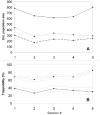Population estimation and trappability of the European badger (Meles meles): implications for tuberculosis management
- PMID: 23227211
- PMCID: PMC3515448
- DOI: 10.1371/journal.pone.0050807
Population estimation and trappability of the European badger (Meles meles): implications for tuberculosis management
Abstract
Estimates of population size and trappability inform vaccine efficacy modelling and are required for adaptive management during prolonged wildlife vaccination campaigns. We present an analysis of mark-recapture data from a badger vaccine (Bacille Calmette-Guérin) study in Ireland. This study is the largest scale (755 km(2)) mark-recapture study ever undertaken with this species. The study area was divided into three approximately equal-sized zones, each with similar survey and capture effort. A mean badger population size of 671 (SD: 76) was estimated using a closed-subpopulation model (CSpM) based on data from capturing sessions of the entire area and was consistent with a separate multiplicative model. Minimum number alive estimates calculated from the same data were on average 49-51% smaller than the CSpM estimates, but these are considered severely negatively biased when trappability is low. Population densities derived from the CSpM estimates were 0.82-1.06 badgers km(-2), and broadly consistent with previous reports for an adjacent area. Mean trappability was estimated to be 34-35% per session across the population. By the fifth capture session, 79% of the adult badgers caught had been marked previously. Multivariable modelling suggested significant differences in badger trappability depending on zone, season and age-class. There were more putatively trap-wary badgers identified in the population than trap-happy badgers, but wariness was not related to individual's sex, zone or season of capture. Live-trapping efficacy can vary significantly amongst sites, seasons, age, or personality, hence monitoring of trappability is recommended as part of an adaptive management regime during large-scale wildlife vaccination programs to counter biases and to improve efficiencies.
Conflict of interest statement
Figures



Similar articles
-
Is moving from targeted culling to BCG-vaccination of badgers (Meles meles) associated with an unacceptable increased incidence of cattle herd tuberculosis in the Republic of Ireland? A practical non-inferiority wildlife intervention study in the Republic of Ireland (2011-2017).Prev Vet Med. 2020 Jun;179:105004. doi: 10.1016/j.prevetmed.2020.105004. Epub 2020 Apr 14. Prev Vet Med. 2020. PMID: 32361147
-
Spatial and temporal analyses of metrics of tuberculosis infection in badgers (Meles meles) from the Republic of Ireland: Trends in apparent prevalence.Prev Vet Med. 2015 Dec 1;122(3):345-54. doi: 10.1016/j.prevetmed.2015.10.013. Epub 2015 Oct 28. Prev Vet Med. 2015. PMID: 26556049
-
Abundance of badgers (Meles meles) in England and Wales.Sci Rep. 2017 Mar 21;7(1):276. doi: 10.1038/s41598-017-00378-3. Sci Rep. 2017. PMID: 28325904 Free PMC article.
-
Mycobacterium bovis infection in the Eurasian badger (Meles meles): the disease, pathogenesis, epidemiology and control.J Comp Pathol. 2011 Jan;144(1):1-24. doi: 10.1016/j.jcpa.2010.10.003. Epub 2010 Dec 4. J Comp Pathol. 2011. PMID: 21131004 Review.
-
BCG vaccination against tuberculosis in European badgers (Meles meles): a review.Comp Immunol Microbiol Infect Dis. 2012 Jul;35(4):277-87. doi: 10.1016/j.cimid.2012.01.009. Epub 2012 Feb 14. Comp Immunol Microbiol Infect Dis. 2012. PMID: 22340983 Review.
Cited by
-
The Irish bTB eradication programme: combining stakeholder engagement and research-driven policy to tackle bovine tuberculosis.Ir Vet J. 2023 Nov 23;76(Suppl 1):32. doi: 10.1186/s13620-023-00255-8. Ir Vet J. 2023. PMID: 37996956 Free PMC article. Review.
-
Super-ranging. A new ranging strategy in European badgers.PLoS One. 2018 Feb 14;13(2):e0191818. doi: 10.1371/journal.pone.0191818. eCollection 2018. PLoS One. 2018. PMID: 29444100 Free PMC article.
-
Engaging With Farmers to Explore Correlates of Bovine Tuberculosis Risk in an Internationally Important Heritage Landscape: The Burren, in the West of Ireland.Front Vet Sci. 2022 Feb 15;9:791661. doi: 10.3389/fvets.2022.791661. eCollection 2022. Front Vet Sci. 2022. PMID: 35242836 Free PMC article.
-
Oral Vaccination of Free-Living Badgers (Meles meles) with Bacille Calmette Guérin (BCG) Vaccine Confers Protection against Tuberculosis.PLoS One. 2017 Jan 25;12(1):e0168851. doi: 10.1371/journal.pone.0168851. eCollection 2017. PLoS One. 2017. PMID: 28121981 Free PMC article.
-
Climate and the individual: inter-annual variation in the autumnal activity of the European badger (Meles meles).PLoS One. 2014 Jan 17;9(1):e83156. doi: 10.1371/journal.pone.0083156. eCollection 2014. PLoS One. 2014. PMID: 24465376 Free PMC article.
References
-
- Delahay R, Smith G, Hutchings M (eds) (2009) Management of disease in wild mammals. Springer, New York.
-
- Daszak P, Cunningham AA, Hyatt AD (2000) Emerging infectious diseases of wildlife – threats to biodiversity and human health. Science 287: 443–449. - PubMed
-
- Lachish S, McCallum H, Mann D, Pukk CE, Jones ME (2010) Evaluation of Selective Culling of Infected Individuals to Control Tasmanian Devil Facial Tumor Disease. Cons Biol 24: 841–851. - PubMed
-
- Knobel DL, Fooks AR, Brookes SM, Randall DA, Williams SD, et al. (2008) Trapping and vaccination of endangered Ethiopian wolves to control an outbreak of rabies. J Appl Ecol 45: 109–116.
Publication types
MeSH terms
LinkOut - more resources
Full Text Sources
Medical

